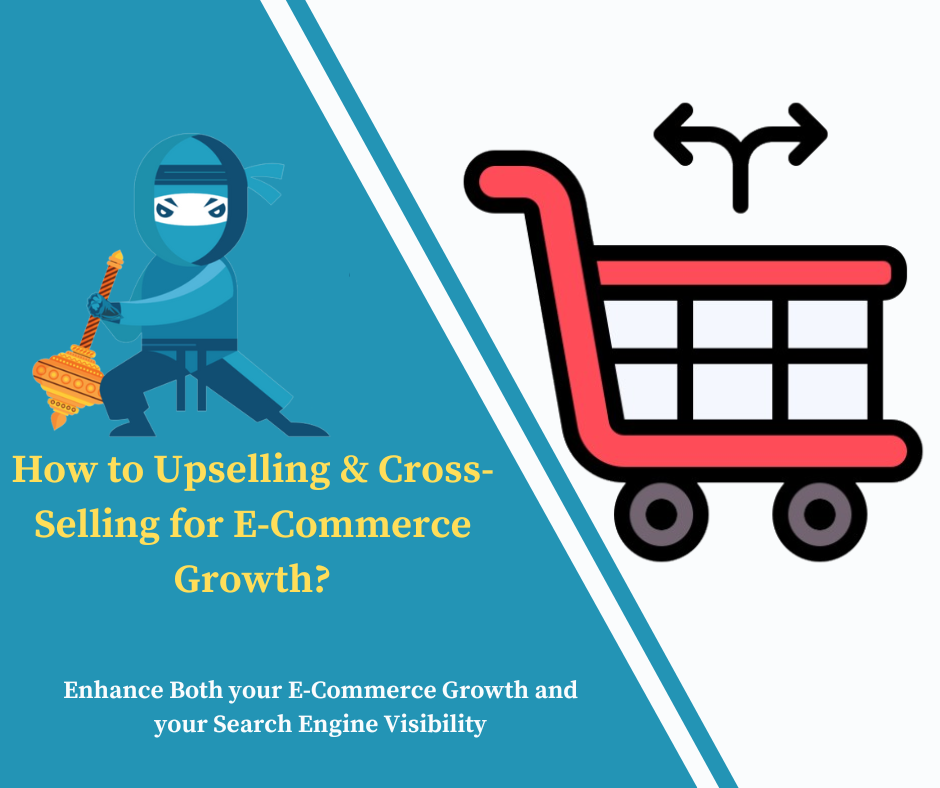How to Upselling & Cross-Selling for E-Commerce Growth?
In the fast-paced world of e-commerce, driving more revenue from every transaction is a critical strategy for growth. Two proven techniques that help maximize profitability are Upselling & Cross-Selling. Both methods encourage customers to spend more while improving their shopping experience, making them essential tools for any eCommerce business. In this article, we will explore upselling and cross-selling, why they are vital for eCommerce growth, and how to implement them effectively.
What is Upselling?
Upselling is offering a customer a more expensive or enhanced version of the product they are already considering. The key here is introducing products with additional features, higher quality, or greater benefits, thereby adding value to the customer’s purchase decision.
For example, if a customer is interested in purchasing a laptop with basic specifications, you could upsell by recommending a model with better features such as more RAM, faster processing power, or additional storage. This increases the customer’s total spend while enhancing their shopping experience.
What is Cross-Selling?
Cross-selling refers to the practice of suggesting complementary or related products that enhance the customer’s original purchase. The goal of cross-selling is not to replace the primary product but to offer additional items that complete or improve the customer’s experience.
A common example of cross-selling is when a customer adds a smartphone to their cart, and the online store recommends items like phone cases, screen protectors, or headphones. These items are related to the initial purchase and add value by offering a more complete product solution.
Also read: How to Increase Conversion Rates Tips for E-Commerce Success
Why are Upselling & Cross-Selling Important for eCommerce Growth?
Upselling & Cross-Selling are essential to increasing both revenue and customer satisfaction. Here’s why these techniques are so valuable:
Increased Average Order Value (AOV):
By encouraging customers to spend more on each transaction, upselling and cross-selling boost your Average Order Value (AOV). This means higher revenue without needing to acquire new customers.
Improved Customer Experience:
When done correctly, upselling and cross-selling can improve the customer’s shopping experience by offering them better, more comprehensive solutions that meet their needs more effectively.
Higher Customer Retention Rates:
Satisfied customers are more likely to return. By offering products that enhance their original purchase or solve additional problems, you build trust and increase the likelihood of repeat business.
Optimized Product Visibility:
Cross-selling is a great way to highlight products that customers might not have considered. By showcasing complementary items, you increase the visibility and sales of products that may not move as quickly on their own. Also read: How Can You Optimize Website Speed & Improve User Experience
Best Practices for Effective Upselling & Cross-Selling
1. Understand Your Customers’ Needs
Knowing your customers is key to effective Upselling & Cross-Selling. Use data analytics tools to gather insights into customer behavior, preferences, and purchase history. This will allow you to make personalized recommendations that feel relevant, rather than pushing random products that might overwhelm or annoy customers.
2. Focus on Value, Not Just Price
When upselling, focus on the value of the higher-priced item rather than just the price difference. Customers will be more inclined to upgrade if they see clear benefits, such as increased durability, enhanced features, or long-term savings. For example, instead of simply showing a more expensive laptop, explain how the upgraded version will help the customer work faster and more efficiently.
3. Use Timing Wisely
Timing is everything when presenting upsell or cross-sell opportunities. The checkout process is one of the best times to offer product upgrades or complementary items, as customers are already in the mindset of making a purchase. You can also introduce these offers during product viewing or immediately after a customer adds an item to their cart.
4. Offer Bundles and Discounts
Cross-selling is more effective when it includes value-added offers, such as product bundles or discounts. For instance, if a customer is buying a laptop, offering a bundle that includes a laptop case, mouse, and external hard drive at a discounted price is more enticing than offering each item separately. Customers perceive bundles as convenient and cost-saving, making them more likely to complete the purchase.
5. Limit the Number of Suggestions
Avoid overwhelming your customers with too many options. Limit your upsell or cross-sell offers to 1-3 products that are highly relevant to their purchase. This reduces decision fatigue and increases the likelihood of conversion.
6. Leverage Product Reviews and Social Proof
When presenting an upsell or cross-sell option, include customer reviews and testimonials to show that others have benefited from the products. Social proof builds trust and helps convince customers that upgrading or adding a complementary product is a wise choice.
7. Post-Purchase Cross-Selling
The relationship with the customer doesn’t end after they make a purchase. Follow up with post-purchase emails to suggest complementary products that they may have missed during checkout. For example, if someone buys a camera, you could suggest lenses, memory cards, or carrying cases in a follow-up email.
Tools and Technologies for Upselling & Cross-Selling
AI-Powered Recommendations
AI tools help eCommerce businesses make personalized upsell and cross-sell recommendations based on customer behavior and preferences. These tools analyze previous purchases, browsing habits, and cart data to deliver relevant suggestions in real-time.
Pop-Ups and In-Cart Suggestions
Adding pop-ups or in-cart product recommendations can help gently nudge customers toward adding more items to their orders. Just be sure that these suggestions are relevant and non-intrusive.
Automated Email Campaigns
Use email automation tools to send post-purchase cross-sell emails. These campaigns can introduce customers to new products or remind them about related items they might have overlooked during their initial purchase.
FAQs
What is the main difference between upselling and cross-selling?
Upselling encourages customers to buy a more expensive or upgraded version of the product they are considering, while cross-selling suggests complementary products to enhance the customer’s main purchase.
How can I ensure my upselling and cross-selling strategies don’t annoy customers?
To avoid annoying your customers, focus on offering personalized, relevant suggestions. Limit the number of options you present and ensure the timing is right—such as during checkout or after the customer has shown interest in a particular product.
Should I use discounts to encourage cross-selling?
Yes, offering discounts or creating product bundles can be a powerful way to encourage cross-selling. Customers are more likely to purchase related items when they feel they’re getting a good deal.
Can upselling and cross-selling work for small e-commerce businesses?
Absolutely. Whether your eCommerce business is large or small, upselling and cross-selling can increase revenue and improve customer satisfaction. For small businesses, it’s important to focus on personalization and to use customer data to make strategic recommendations.
How do I track the effectiveness of my upselling and cross-selling strategies?
Use analytics tools to track metrics such as conversion rates, Average Order Value (AOV), and Customer Lifetime Value (CLTV). These metrics will help you gauge the effectiveness of your upselling and cross-selling efforts.
What is the ideal time to offer upsell and cross-sell suggestions?
The best times are during the checkout process, on product detail pages, or after a customer adds an item to their cart. You can also send post-purchase emails with cross-sell suggestions to encourage repeat purchases.
Conclusion
Upselling & Cross-Selling are essential strategies for driving e-commerce growth. When done correctly, they not only boost revenue but also enhance the customer experience. By focusing on personalization, offering value, and leveraging tools like AI and automated emails, you can implement these techniques effectively and see tangible results in your eCommerce business.








